For as long as there’s been communication, there’s been promotion. But what does it take to create a successful digital PR campaign? The truth is, there are 1,001 ways to raise the profile of your brand or client. In this article, we’ll take you through the 10-step process we recommend for every PR pro looking to earn press coverage.
1. Set Your Goals
As with any campaign, you need to decide what you (or your clients) want to accomplish, so you can measure against it at the end. Remember to make your goals a qualitative statement, then quantify them with key results.
For example:
Goal: Boost campaign-relevant traffic to the website
Key result:
Get 25 links to a targeted campaign landing page
Generate 1k sessions to a targeted campaign landing page
Goal: Land far-reaching coverage in major online publications
Key result:
Earn 10 pieces of syndicated content
Land coverage in 6+ publications with a domain authority of 85+
Here are some more examples of key results PR pros might measure coverage by:
Number of clicks/amount of traffic
Uplift in rankings
Number of brand mentions
Number of co-citations (links to content mentioning your brand or campaign)
Number of impressions generated
Coverage gained in a specific media outlet
Number of PR-assisted sales
2. Organize Budget, Sign-off, and Documentation
At this stage of your digital PR campaign, you’ll want to:
Decide the budget you are able allocate to the campaign (if any)
Determine the sign-off process (try to negotiate as few tiers of sign-off as possible)
Agree upon the level of innovation (how creative and “out there” your idea is allowed to be)
In their webinar, How To Pitch Creative Ideas (That Actually Get Signed Off), digital PR agency Bottled Imagination revealed how they mark all their campaigns up on an “Innovation scale” and have a great PR strategy for getting buy-in from clients for more “creative” press ideas. This example is used for agency pitching, but the same can be applied in-house.

Watch: How To Pitch Campaign Ideas That Actually Get Signed Off
During this stage of the process, you should also be documenting everything, including:
Client interviews for journalist requests (email, bio, contact details, etc.)
Signed-off comments from clients on relevant topics, as their comments can be used for all kinds of journalist contributor requests
Expert/contributor images and headshots (color, black & white, transparent background, etc.)
According to Cision research, it’s not uncommon for journalists file up to 10 stories a week. They need information, and they need it fast. Having commentary and assets prepared earlier means you help journalists meet their deadlines and push out high-volume, high-quality content.
3. Define Your Audience
Whether you're pitching journalists or driving traffic, relevancy is more important than ever in PR right now.
Relevancy in pitching terms means choosing the right journalists with the right audiences.
Relevancy in SEO/traffic terms means driving those audiences back to the right pages on your site, with the right keywords, to improve your topic authority in search engines.
And getting the first part right makes the second part a whole lot easier.
Relevancy is key today because boardrooms and clients are demanding more than just top of the funnel results from digital PR pros. They want audiences who are considering and converting. And for that, they need to get in front of hyper-relevant audiences.
If you want to forensically investigate the audience of your brand or client, head to SparkToro.
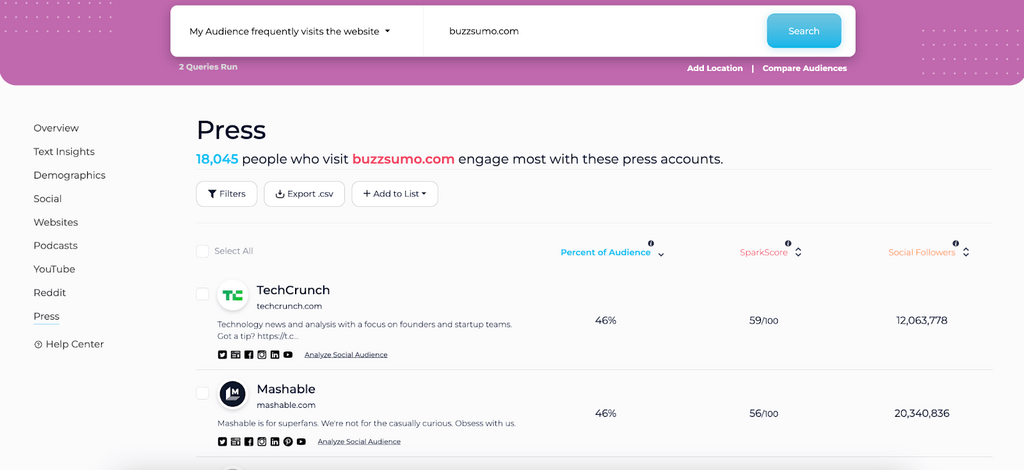
A quick search for a website in the SparkToro dashboard will show you key audience insights, including:
Demographics
Social accounts they follow
Websites they interact with
Podcasts they listen to
Subreddits they’re members of and, crucially...
Press accounts they find most engaging
I’ve been on the receiving end of agency pitches that have been exceptionally generic. The problem? The person pitching didn’t ask our team about our audience – an audience which we spend most of our working days trying to figure out.
Tools like SparkToro can go a long way in helping you get into the mind of an audience; however, nothing can replace that quality of insight that comes from talking to customers, customer-facing teams, and – if you’re agency side – clients.
All the information you gather will be key to creating a relevant press idea.
4. Research Your Press Idea
Once you know who you’re targeting, you can get creative. Here are some different avenues to explore with your PR campaign idea:
Reactive PR and Newsjacking
Capitalize on breaking news or trending topics by conducting relevant research, gathering data, and pitching expert commentary or analysis to journalists covering the story.
Diversified Content Formats
Our research proves that press releases, surveys, and data-driven research are the most effective content formats to pitch journalists.
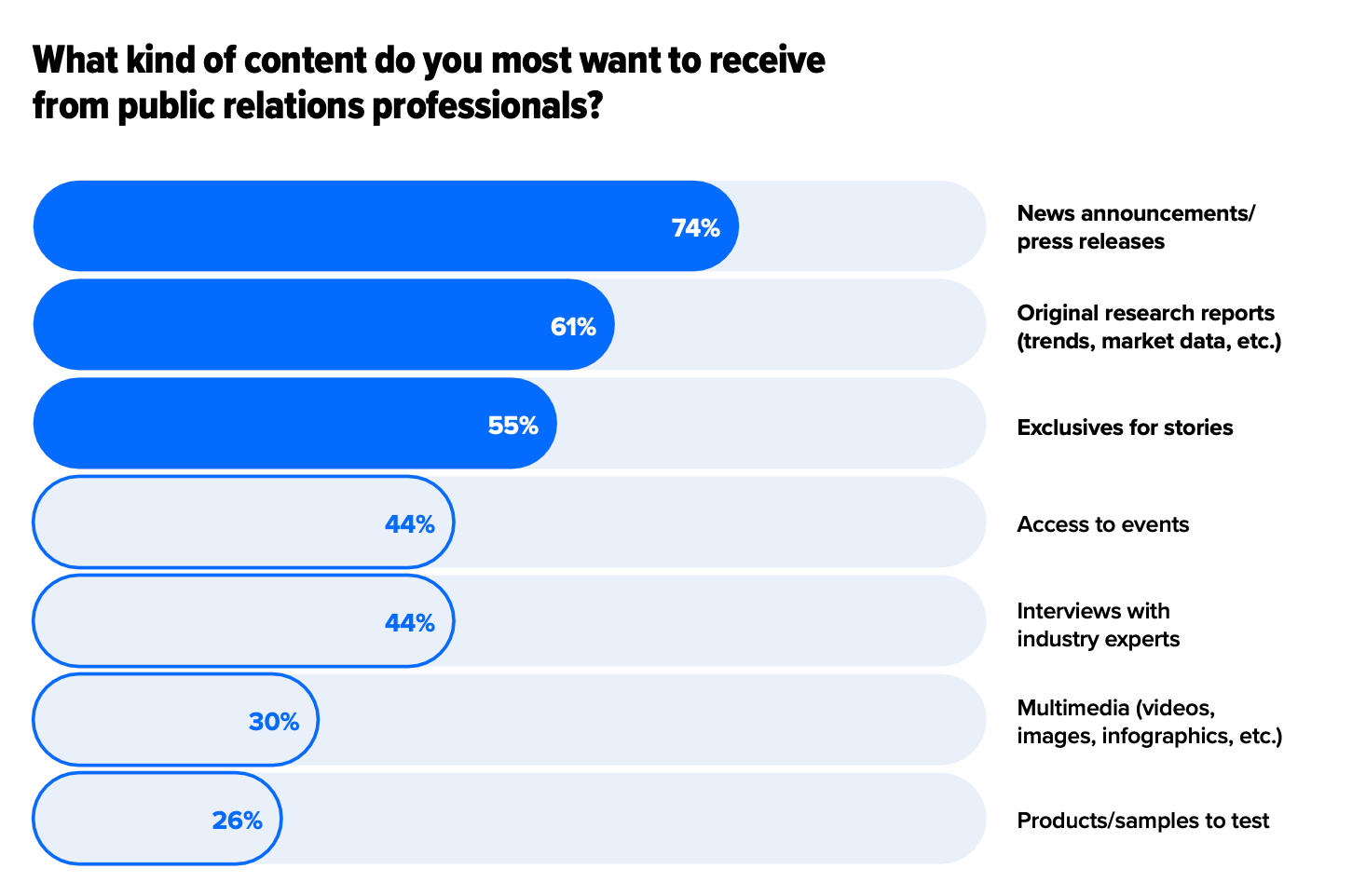
But this doesn’t mean you shouldn’t consider diversifying your content formats to stand out from the competition.
Explore interactive elements like calculators, maps, morphing GIFs, or compelling visuals that can capture journalists' attention and provide a fresh perspective on your topic.
Regional and Niche Angles
Think beyond just national coverage and consider tailoring your campaigns to include regional or niche angles that can appeal to local publications or industry-specific outlets. This approach can help you build a diverse portfolio of high-authority links from a wide range of sources.
“With clients we always try to have at least one ‘Regional hook’ campaign, where we have data down to a state level and, even better, a city level. Any time you do that, you suddenly open up your network to hundreds of other regional publishers. They generally have a domain authority of 70 or above, which is really great – that's my threshold for what is a real authoritative site. There are radio stations, there are news publishers, there's ABC, CNBC, Fox, and they all have regional sites. So any time you can have regional data in a campaign you're going to get even more than just national news.”
Kelsey Libert, Co-Founder of Fractl
Earning Press Coverage With Insights From 5K Campaigns
Get Ideas from Journalist Content
Keep up to date with a journalist’s latest work, and let their best content inspire your next PR idea.
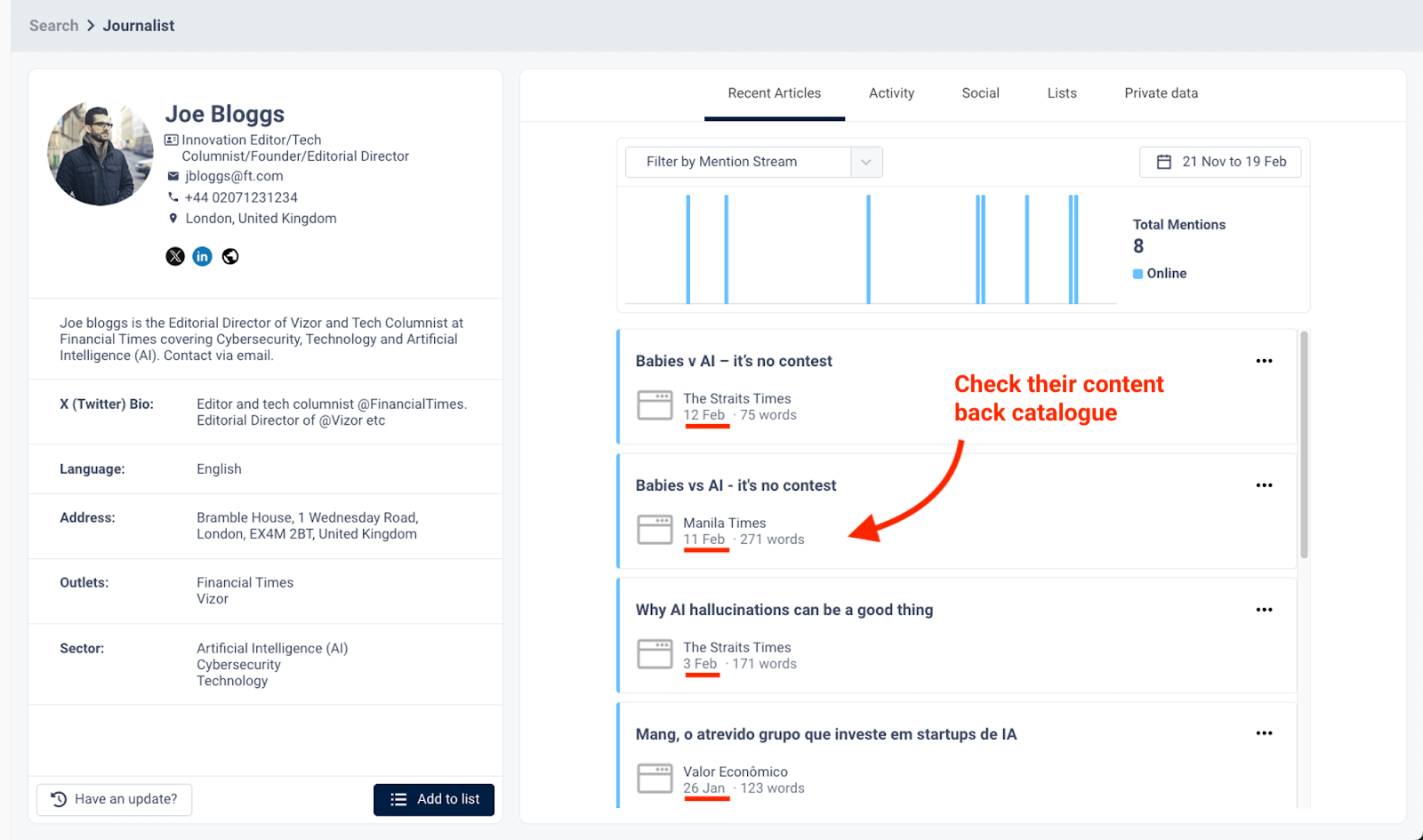
Get Inspiration from Existing PR Campaigns
Track down successful campaigns to inspire your next PR campaign strategy. Follow publishers and online content curators to see the best examples, including:
The Grapevine newsletter by PR expert Iona Townsley
Unbottled newsletter by Bottled Imagination
Once you have a bunch of relevant topics, start brainstorming your actual press idea.
At this point consider:
Campaign format
“Innovation level”
Agreed upon goals and key results
Budget and resources
5. Pitch an Idea and Get Sign-Off
This is when you really need to focus on validating your idea with data. Why should your team or clients buy into it? How does it help them achieve their goals? For the decision makers: how will it save or earn them money?
Here are a few ways you can build trust in your idea:
Prove Engagement
Can you prove that there is a strong appetite for this kind of PR content using search data from Google Trends…
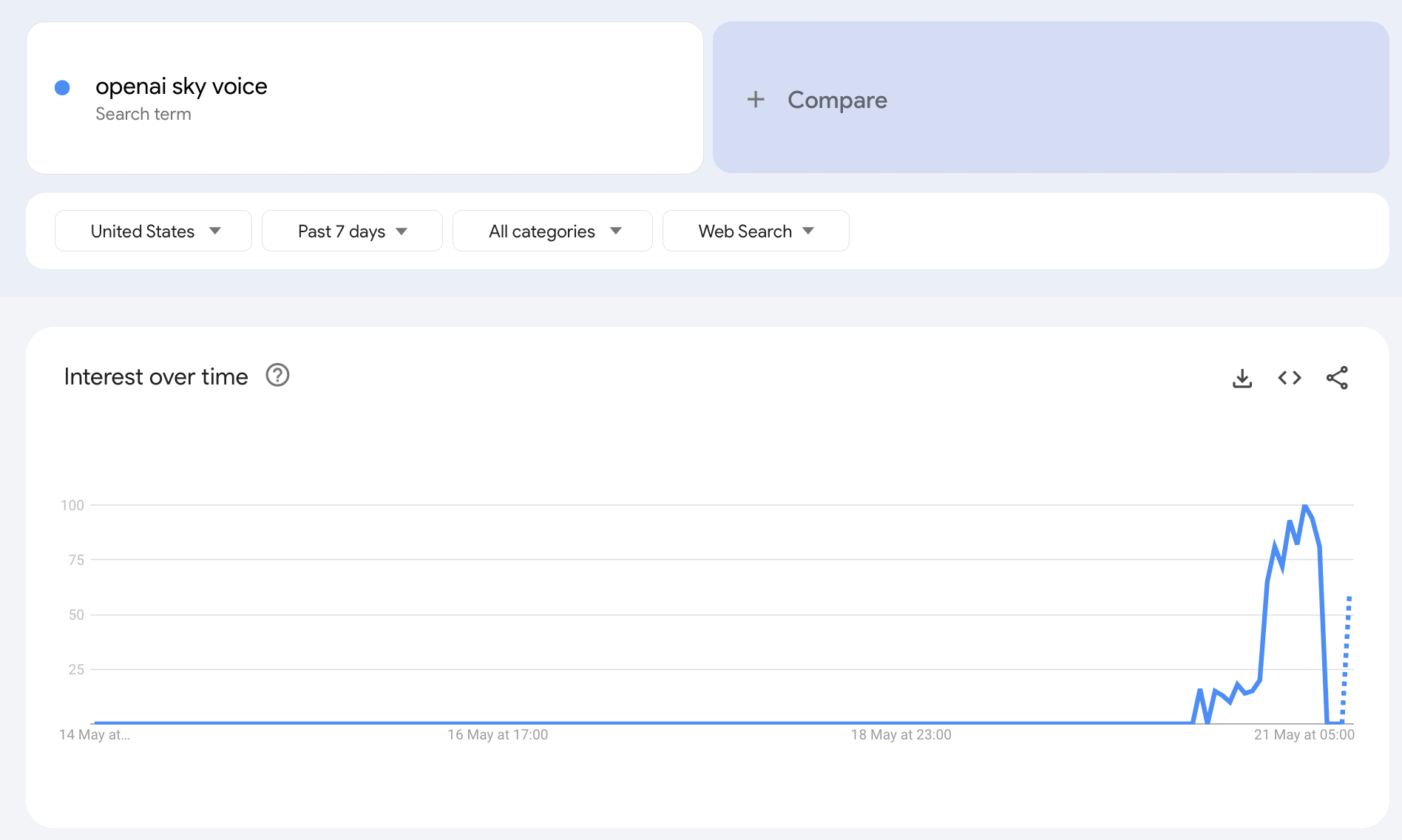
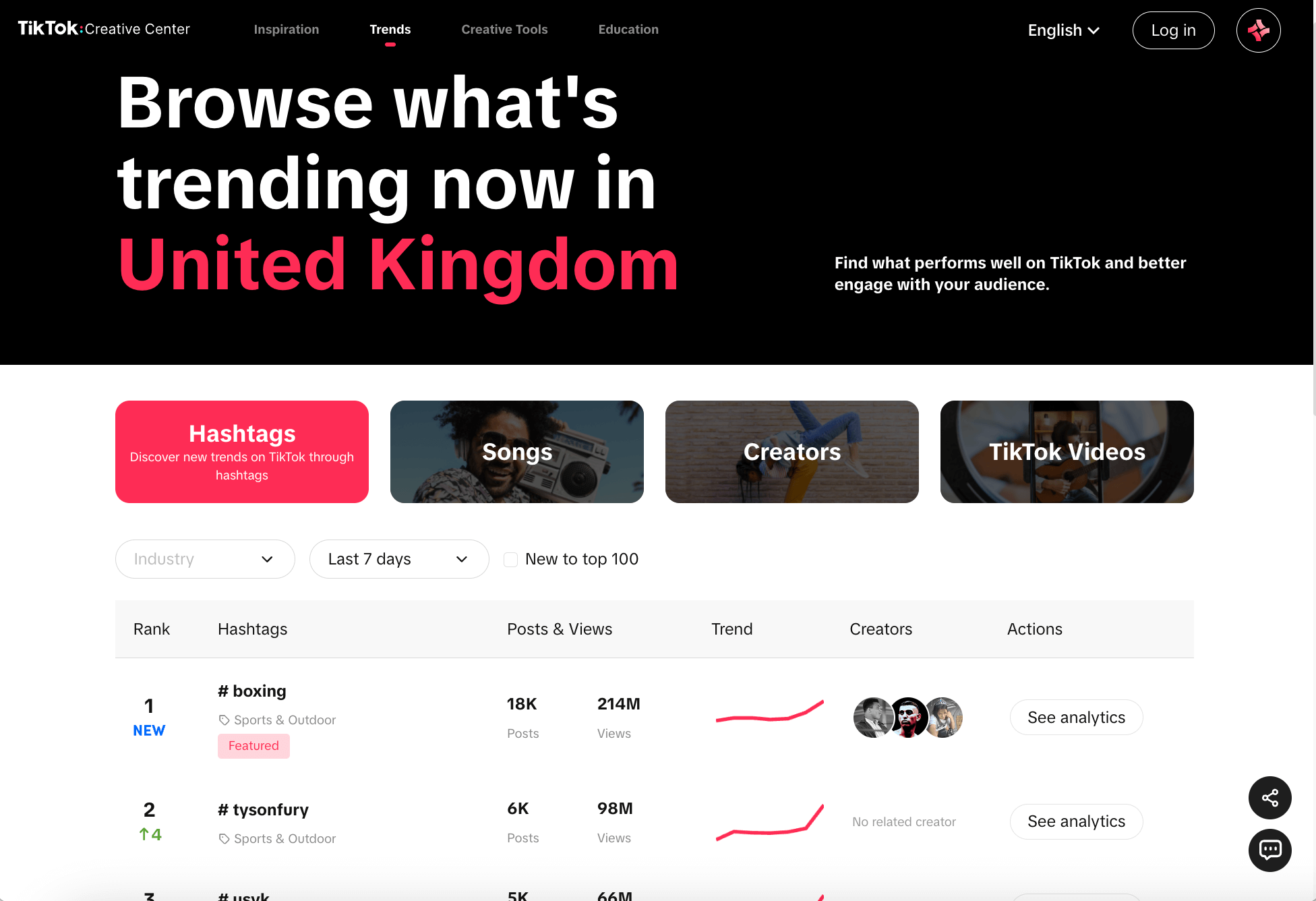
Showcase Cost Savings
Do the keywords surrounding your campaign have a high paid media cost-per-click (CPC) – meaning it’s more commercially viable to earn relevant, organic coverage around the campaign topic versus spending money for it via paid media?
Prove Traffic Potential
Present the number of links, and the amount of traffic opportunity your campaign topics are able to earn using tools like Ahrefs’ Content Explorer.
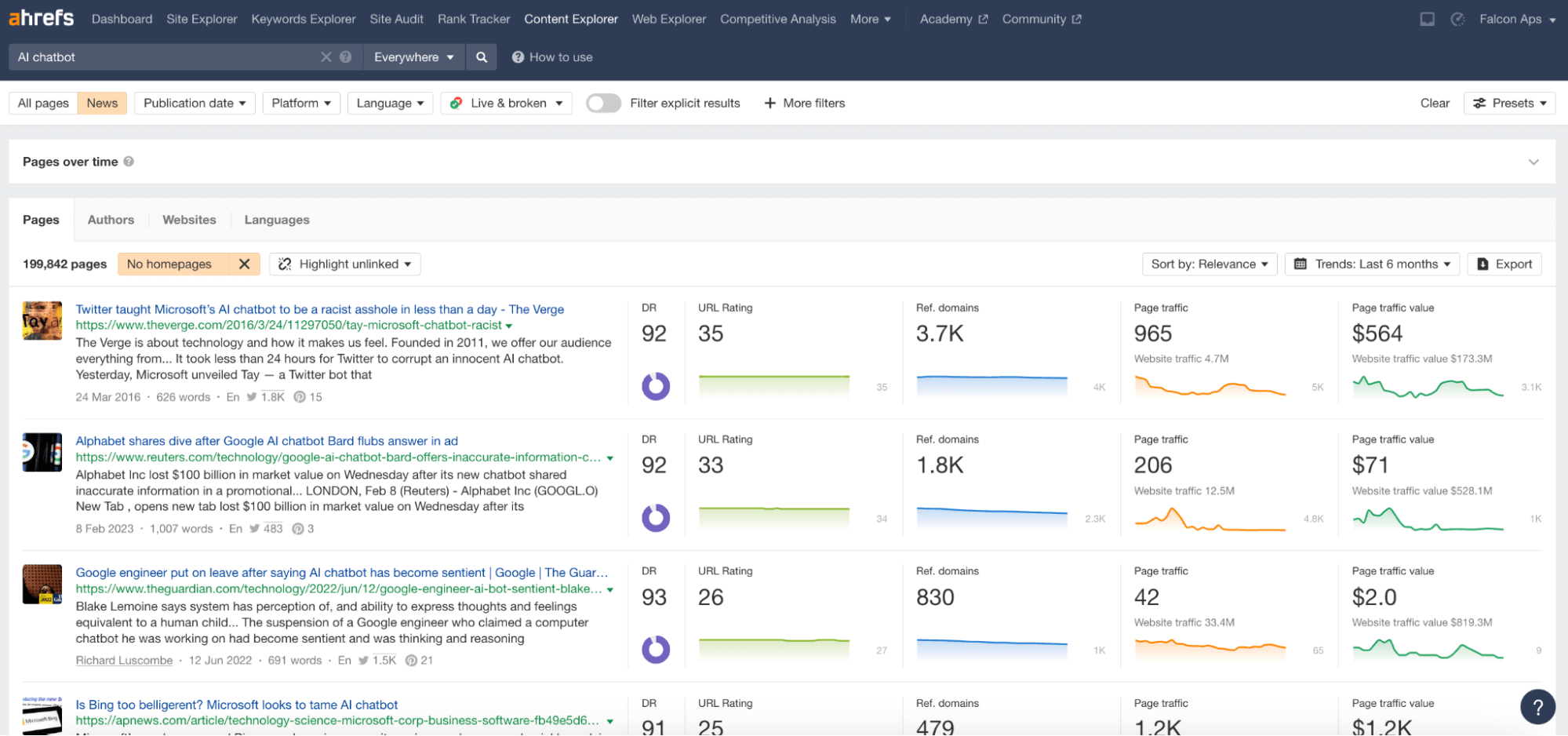
6. Create the Campaign and Review It
Start gathering all your strategic outputs. Once your campaign is at the point of final review, you should begin involving anyone who needs to pass comment – i.e. clients or experts.
Kelsey Libert, PR expert and Co-Founder of Fractl, reported that she is increasingly receiving requests for commentary and quotes, alongside all kinds of PR campaigns.
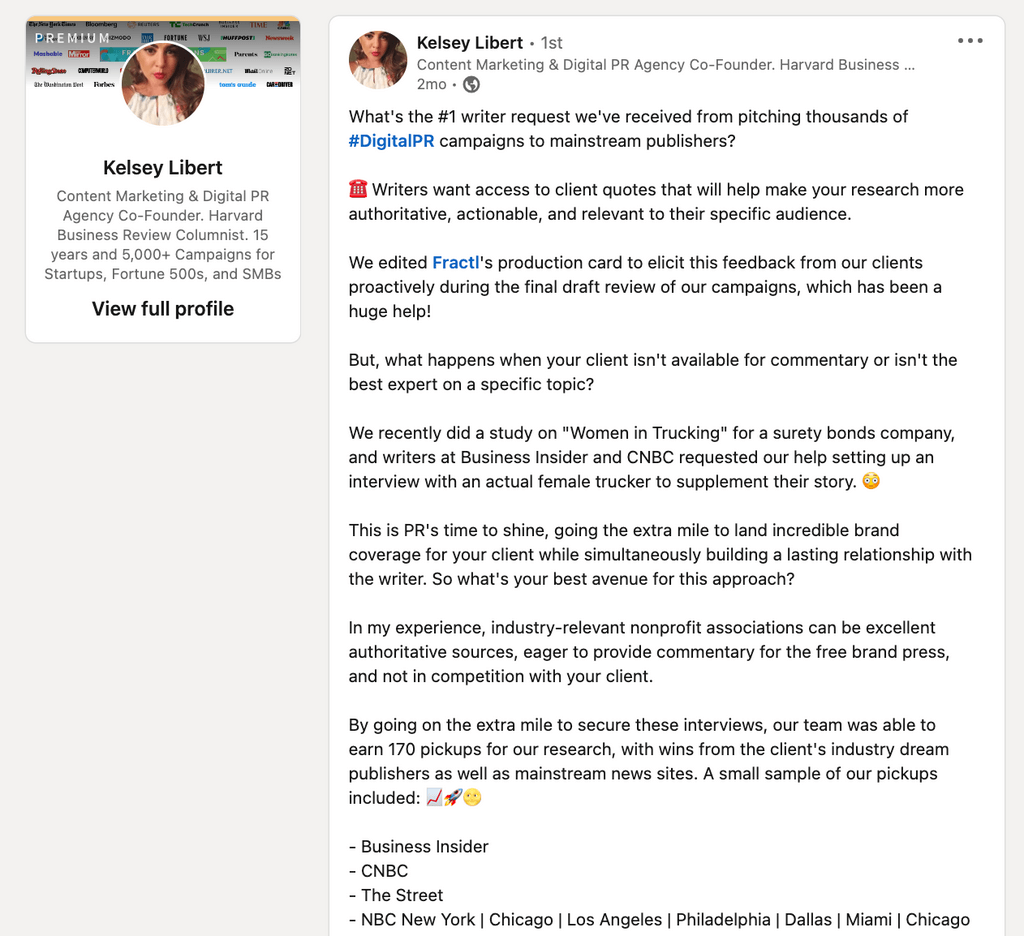
7. Research and Build Your List of Journalists
The fate of your digital PR campaign lies in a journalist’s hands – that’s why you need to be hanging off of their every word.
Here are a few ways you can build your media list of journalists.
1. Find the journalists who are writing about your key campaign topics...
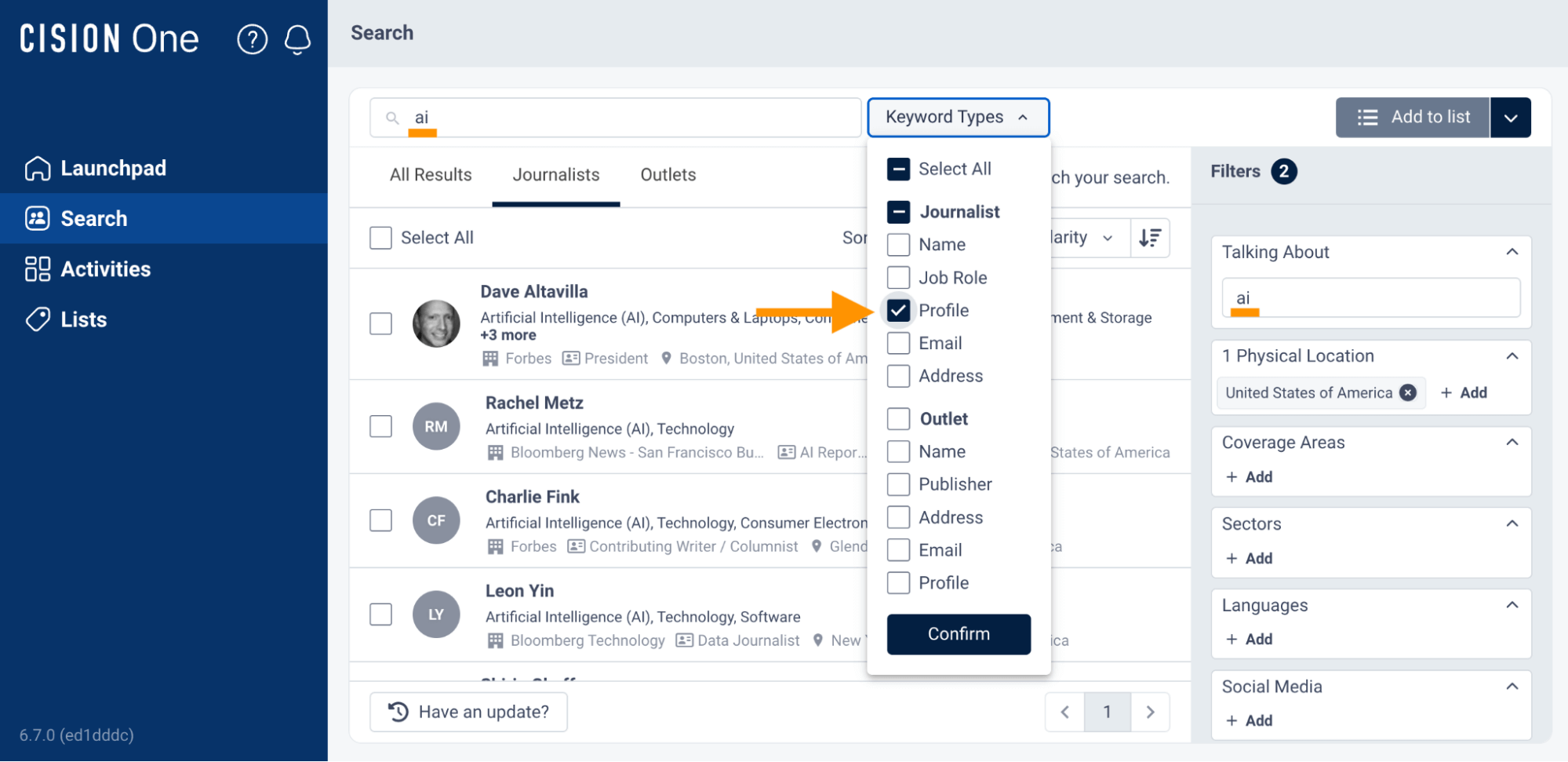

3. If you’ve created a specific format of content, like an infographic, track down journalists that have already published infographics.
4. Research relevant media outlets and work backwards from there.

Once you’re happy you’ve sourced relevant journalists who will genuinely care about your content, then bank them to your media list.
To do all of this research, make sure you have access to a journalist database with an archive of media coverage and regularly updated information.
8. Pitch to Journalists
At this point you need to make sure that your pitches are as personalized as possible. Prove to a journalist that you’ve done the legwork to understand their beat and back catalogue. If you can get hold of their top performing content, reference it and demonstrate how your story will help them replicate that success. And heed the advice of PR expert Domenica D’Ottavio, Associate Director of Digital PR at Journey Further:
"Pitching ain't easy." It's not as simple as emailing a journalist and watching the placements roll in.
In 2023, journalists outnumber PR pros by 7 to 1.
Now, more than ever, it's essential to start on the right foot - by building relationships. These journalists are likely folks that you will be reaching out to for the remainder of your career. Refrain from burning bridges by sending irrelevant, off-beat pitches to contacts who don't care about what you're pitching.
Instead, remember that journalists are people first and foremost, and they have a job to do.
Ensure you craft an email that:
Acknowledges that you've read their work and know what they're about and
Helps them do their job, either by providing them ideas, content, or data or offering to connect them with subject matter experts
Does your press release offer something new for their readers? Does it answer a question or challenge an existing convention? Is it newsworthy, surprising, or does it evoke an emotion? Journalists want readers to engage with their articles and stay on the page, so only send press releases that you know are primed to entertain their audience.
Domenica D'Ottavio
Associate Director of Digital PR
Here are three more tips for pitching journalists:
Prioritize Personalization
Personalization is crucial when pitching journalists and building relationships with them. Go beyond simply addressing them by name; find ways to connect with their interests, recent work, or personal anecdotes they've shared. This level of personalization will make your pitch stand out and increase the likelihood of a positive response.
Engage on Social Media
Social media platforms like X/Twitter can be powerful tools for building relationships with journalists before pitching them. Follow relevant journalists, engage with their content, and share insights or quotes from their work. This proactive approach will make you more recognizable when you eventually pitch them.
Offer Exclusive Access
Instead of mass-pitching your content to multiple journalists simultaneously, consider offering exclusive access to a select few, high-authority publications or writers first. This exclusivity can be compelling for journalists and increase the chances of your content being covered.
“The most effective thing to do is to [conduct] high touch outreach to select publishers that you know are going to have the biggest syndication networks. Go for them first, because then you can get in with a writer that's going to syndicate to 100 other writers.”
Kelsey Libert, Co-Founder of Fractl
Earning Press Coverage With Insights From 5K Campaigns
9. Win the Pitch and Coordinate with Journalists
This step is simply about general etiquette when you’re working with journalists to deliver the story:
Be responsive if a journalist needs more information from you
Don’t pester or follow up too often
Don’t request to make edits – respect their expertise
Be clear (but not pushy) about reference and link requests
Be friendly and appreciative
You can find out more do’s and don'ts of pitching, based on real responses from over 3,000 journalists, in our State of the Media Report.
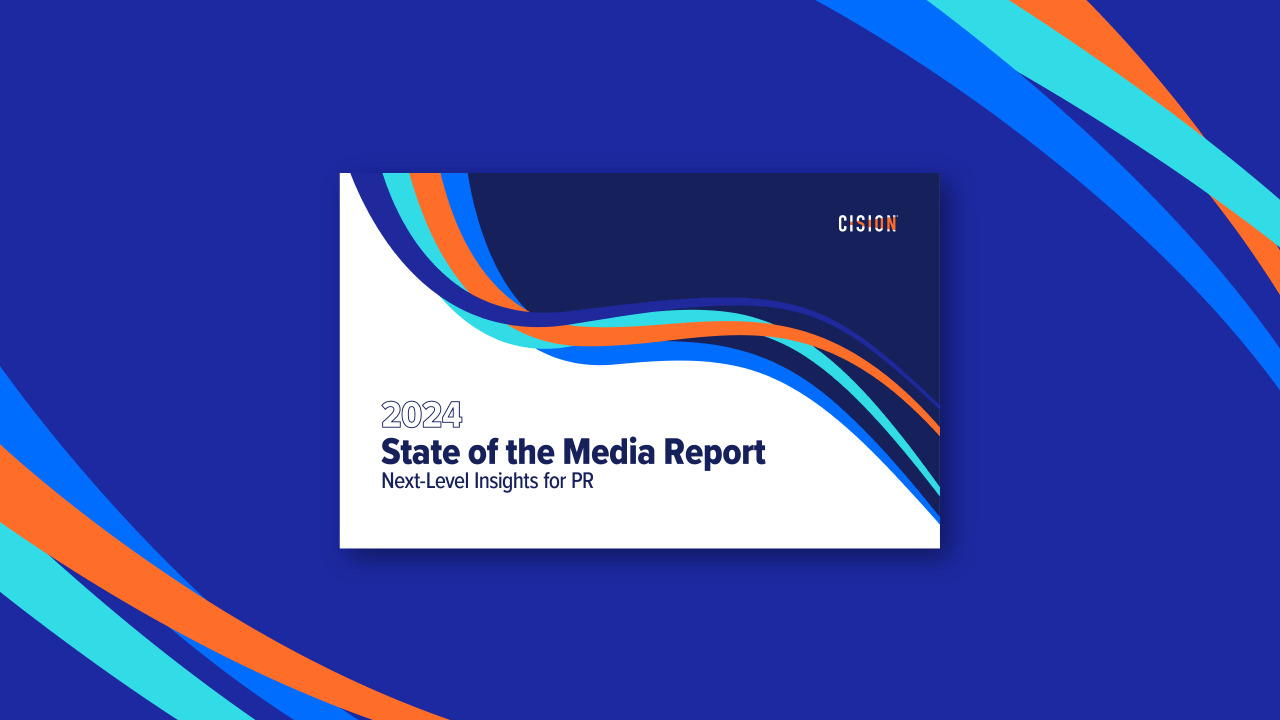
10. Monitor Coverage and Report On Goals
To track the success of your PR campaign you need to be using a PR tool that specializes in media monitoring, so you can get instant alerts of coverage.
It’s important to bring together data that can help you benchmark the actual performance of your campaign against the key results you set at the beginning. This is especially important if you set multi-disciplinary goals (e.g. social, search, PR, etc.).
To do this, some PR pros build their own PR dashboards using Google’s Looker Studio, or internal software.
Other tools, like CisionOne, give PR practitioners business-critical data in preconfigured dashboards, so they can easily slice and dice campaign performance.







